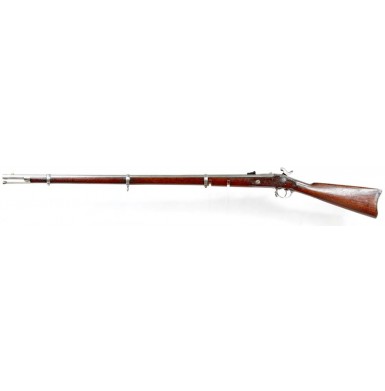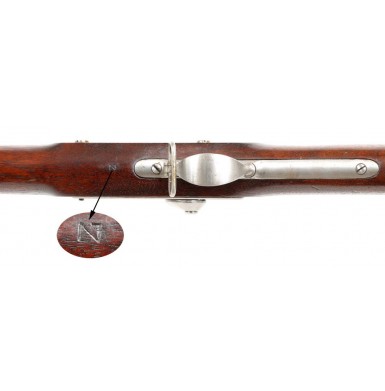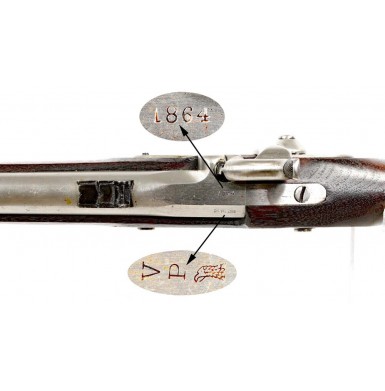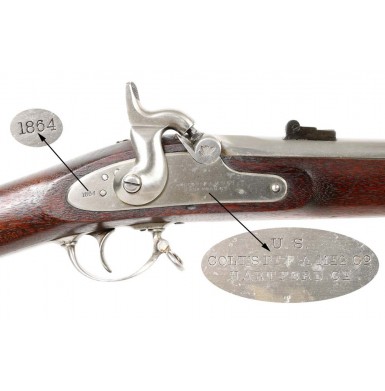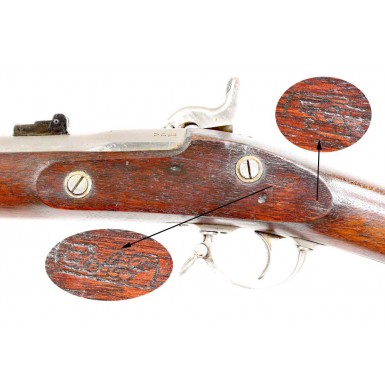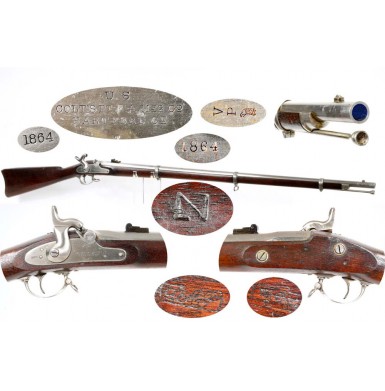Confederate Repaired Colt Special Model Rifle Musket
- Product Code: FLA-3443-SOLD
- Availability: Out Of Stock
-
$1.00
The story of the origin of the Special Model 1861 Rifle Musket as designed by Samuel Colt and produced by The Colt Patent Firearms Company, Lamson, Goodnow & Yale and Amoskeag, is one of the more interesting stories in Civil War firearms manufacturing. The story starts nearly a decade before the American Civil War with the British involvement in the Crimean War, which started in 1854. With a huge and sudden demand for the newly adopted Pattern 1853 Enfield rifle musket, the British looked to makers outside of England to produce the additional guns that they needed. One of the companies they turned to was Robbins & Lawrence, a firm that had been mass producing firearms on the principle of interchangeable parts for some time and had also been involved with the manufacture and installation of the gun making equipment at the Royal Small Arms Factory at Enfield Lock. These experiences made them particularly able to produce Enfield rifle muskets for the British and so Robbins & Lawrence was granted a contract to produce 25,000 Pattern 1853 Enfield rifle muskets. At the same time, the ever-industrious Sam Colt was in the process of setting up his gun making facility in London and approached the British government with an offer to produce interchangeable parts Enfield rifle muskets at a mere $7.50 each! That was less than half of what the Crown was currently paying for contractor-produced muskets that were not made with interchangeable parts. The caveat to Colt’s offer was that the contract had to be for one million guns! The Crown rejected the offer, and it was a good thing for Colt. The war in the Crimea ended much sooner than expected, and the British cancelled all of their outstanding orders for Enfields that had been placed with non-English contractors. This resulted in Robbins & Lawrence, who had spent a significant amount of money on machinery and tooling to produce Enfields (and who had only delivered about half of the initial order of 25,000), filing for bankruptcy and having their assets sold at auction. Gun manufacturers like Lamson, Goodnow & Yale (LG&Y), Colt and Whitney descended on the auction and bought machinery, tooling and already fabricated gun parts for pennies on the dollar. This placed these companies in particularly good positions to vie for US Government contracts with the coming of the American Civil War. When the war commenced, Colt immediately approached the US War Department with an offer to manufacture as many 500,000 rifle muskets per year. While Colt’s production estimates were certainly overly optimistic, his company was known for quality and mass production. After some wrangling, Colt secured an initial contract for “25,000 muskets of the exact pattern now being made at the United States armory at Springfield”. Colt actually had no intention of producing exact replicas of the US M1861 “Springfield”, but rather a somewhat simplified design of his own that outwardly resembled the M1861 but inwardly was much more akin to the Enfield. This way he could use many of the parts, machinery and tooling which had been acquired by the various makers at the Robbins & Lawrence auction. In June of 1861, Colt’s chief designer, Elisha Root, approached Erskine S Allin, the Master Armorer at the Springfield Arsenal with his design for what would be eventually be known as the US M1861 “Special Model” Rifle Musket. Between the two of them, the first sample musket was produced and forwarded to Colt to use as a pattern gun. The gun incorporated screw fastened clamping barrel bands (like the Enfield) instead of solid bands that were retained by springs. There were mechanical changes in the lock to make it more “Enfield-like” internally, and the more direct breech vent eliminated the need for a clean out screw as was necessary for the 90-degree turn found in the bolster of the Springfield design. The one improvement of Root’s that most impressed Allin were modifications to the M1858 pattern rear sight that was due to be used on the M1861 muskets. First, Root designed the sight base walls to be higher, which protected the 100 & 300-yard sight blades when they were lying flat. He also recessed the head of the screw that the sight blades pivoted on, which protected the screw from damage. Finally, he squared off the tops of the sight leaves and deepened the notches. This made the sight leaves easier to move and adjust with a fingernail and made the sight picture clearer. Allin was sufficiently impressed with these improvements that the Root designed M1861 rear sight was adopted in July of 1861 and replaced the M1858 rear sight on the M1861 Rifle Musket. Thus the Special Model 1861 Rifle Musket was born. Over the next three years, Colt, LG&Y and Amoskeag would produce over 185,000 of these guns for US government and several state contracts. 177,026 of these guns were delivered to the US Ordnance Department. With Colt delivering 100,005 between 1862 and 1864, LG&Y delivering 50,020 during the same period and Amoskeag delivering 27,001 between 1863 and 1865. Many of the design changes and manufacturing improvements included in the “Special Model” would become standard features on the US M1863 Springfield Rifle Musket, when it was redesigned during the course of the war.
The Colt Special Model 1861 offered here is in VERY FINE condition overall. However, it is more interesting than it first appears. The gun was repaired at a Confederate facility, probably the Richmond Artillery Workshop, which was where much of the Richmond Arsenal small arms repair work was performed. The gun is marked in the wood, forward of the triggerguard, with a ““ capital letter Z. Other repaired arms are known with similar sized and styled capital letter marks in the same location, including guns with the letters F, Q, R and T. It is still unclear if these letters represent a workman or an inspector. Samples of the “F” and “Q” marks are shown in Chapter 2 of The English Connection, shown on repaired Enfield rifle muskets. In all cases, when the mark is found, a repair, which is not always obvious, is found on the gun as well. One of the more common examples of these repairs is on US M1842 muskets that are found with mixed lock and barrel dates in stocks without any cartouches. The stocks appear to be either left over Harpers Ferry inventory or Richmond made stocks, and as the guns are interchangeable, it was not important to worry about matching original parts, and lock and barrel dates were irrelevant. In the case of this gun, the repair was not immediately evident, but there was a hint; the usually present STEEL mark on the left barrel flat was not present. That lead me to believe the barrel was not the original Colt factory barrel. Disassembly of the gun proved this hypothesis correct. Under the barrel the following marks were found: an A within a star, a P and the sub-inspection initials L.F.R.. This final mark was the indicator that the barrel was not a Colt barrel. This mark is that of armory sub-inspector Lafayette F. Rogers, who is most commonly associated with inspecting Smith Patent carbines during the American Civil War. Rogers did inspect M1863 contract rifle musket barrels produced by Samuel Norris and William T. Clement for the state of Massachusetts; these are the guns that are marked: S.N. & W.T.C. / FOR / MASSACHUSETTS in three lines on their locks. As noted, the M1863 Rifle Musket was derived from the M1861 Special Model and these is some level of interchangeability between the arms. While a M1861 barrel would not fit in a M1861 Special Model stock, a M1863 pattern barrel would. Obviously, the Colt Special Model musket had a damaged barrel that was replaced by the S.N. & W.T.C. barrel in Richmond. If the “Z” mark on the stock were not present, this would simply be a mixed parts gun. In this case, that mark indicates that the repair by use of mixed parts is of the period and makes this gun a much more interesting rifle musket.
As noted, the gun is in VERY FINE condition overall. The lock is clearly marked in three horizontal lines forward of the lock: U.S. / COLT’s PT F. A. MFG Co / HARTFORD, CT and is dated 1864 behind the hammer. The upper left barrel flat is crisply and deeply marked with the usual US V / P / Eagle Head proof marks, and the date 1864 is stamped on the top of the breech. The bolster of the reused S.N. & W.T.C. barrel is clearly marked with a US “Spread Winged Eagle”, which remains crisp and clear. In typical Colt fashion, the metal parts are marked with a plethora of small sub-inspectors’ marks, including a C at the front of the triggerguard plate, an P on the triggerguard, and a clear US on the buttplate tang along with an C sub inspectors mark. All of the barrel bands bear the usual U mark for “up” on their obverse and are also sub-inspected on the reverse. The upper barrel band is marked with an D, the middle and lower bands are marked with an M. The stock also shows fine inspector marks, with two excellent US inspector cartouches on the flat opposite the lock; a script DAP (Dwight A Perkins) a script JT (Jonathan Taylor). Both cartouches are within rectangular boxes with rounded edges. The stock also shows a crisp Z forward of the trigger plate; the mark that started my investigation into the gun. Neither the rear sight base or the sight leaves have the usual Colt style inspection marks, suggesting that the rear sight is one originally attached to the Norris & Clement barrel.
The gun is extremely crisp throughout and very well marked, with all marks remaining clear and sharp. The gun is 100% complete, correct and original in every way, as repaired during the war. The lock plate retains some of its bright and shiny polish. The plate retains very clear markings with only some light frosting, minor light surface oxidation and discoloration from old oil. The lock functions perfectly and remains extremely crisp and tight on all positions. The metal of the barrel is mostly bright, with some dulling towards pewter due to age. The barrel shows some scattered areas of minor frosting as well, along with some discoloration due to age and light surface oxidation, along with a few darker oxidized flecks of discoloration. There are also traces of old dried oil in the nooks and crannies of the metal surfaces. It would probably take only a little effort, some oil and some carefully used 0000 steel wool to return the barrel to its original arsenal bright appearance. The barrel is almost entirely smooth but does show some very tiny scattered flecks of light pinpricking, mostly around the muzzle area and a small amount near the breech. The couple of thumb sized patches of oxidation visible in the photos between the lower and middle bands are simply discoloration and not pitting. The bore is in bright, VERY FINE condition as well, and retains strong, crisp rifling. The balance of the bright metal furniture matches the condition and patina of the barrel perfectly. The original multi-left rear sight is present and retains about 80%+ original, bright blued finish on the base and a similar amount of bright blue on the sight leaves. The sight is somewhat tacky with layers of old oil or grease that should probably be removed, but almost certainly protected the blue over the years. The original sling swivels are present as well on the triggerguard bow and the middle barrel band. The original, full-length, straight-shank, tulip head rammer is present as well and retains fine threads on the end. The stock is full-length, solid and free of any cracks or repairs. The stock is extremely crisp and sharp and even retains some traces of the original “feathers’ in the wood. The edges are extremely sharp and there is no evidence that the stock has ever been sanded. As would be expected, it shows a handful of minor bumps, dings and minor surface scuffs from use, handling and storage over the past 150+ years. As would be expected from any Colt firearm, the stock displays and retains excellent wood to metal fit throughout. The only minor exception is the Confederate installed Norris & Clement barrel, which does not fit against the lock perfectly, but does fit the wood perfectly.
Overall this is an exceptionally attractive and very high condition example of one of the most desirable contract guns used by the US military during the American Civil War, with the added feature of having been repaired in Richmond. The gun appears to be 100% Colt, with exception of the barrel and rear sight. One can only imagine what happened to the original Colt barrel, and how this late in the war the Confederacy managed to obtain the gun in otherwise very fine condition. By mid-1864 the repair of arms was starting to replace the manufacture arms in Richmond as the primary arsenal activity, so the dates on the gun do make sense. Rarely do you get the opportunity to obtain a rifle musket that tells so many stories all at once; the story of Colt and Elisha Roots’ redesign of the US M1861 rifle musket into the M1861 Special Model rifle musket, the story of that gun influencing the adoption of the US M1863 rifle musket, and the illustration that an M1863 barrel fits a M1861 Special Model stock, as demonstrated by a Confederate repair. This is a very cool musket, with a great story to tell and one that will be a very nice addition to your collection.
SOLDTags: Confederate, Repaired, Colt, Special, Model, Rifle, Musket


